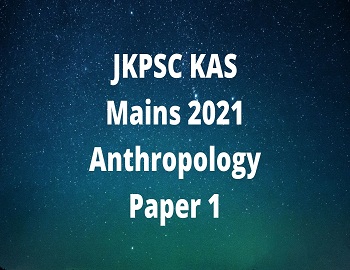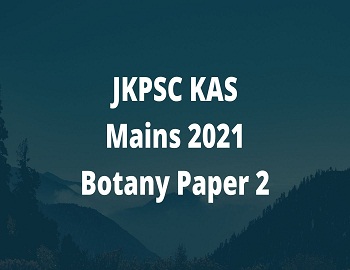JKPSC KAS Mains 2021 Zoology Paper 1:
Please read each of the following instructions carefully before attempting the paper.
(i) There are eight questions divided in two Sections and printed in English. Candidate has to attempt Five questions in All. Questions No. 1 and 5 are compulsory and out of the remaining, any Three are to be attempted choosing at least One question from each Section. The number of marks carried by a Question/Part is indicated against it. Answers must be written in English in Question-Cum-Answer (QCA) Booklet in the space provided.
(ii) Your answer should be precise and coherent.
(iii) If you encounter any typographical error, please read it as it appears in the text book.
(iv) Candidates are in their own interest advised to go through the general instructions on the back side of the title page of the Answer Script for strict adherence.
(v) No continuation sheets shall be provided to any candidate under any circumstances.
(vi) No blank page be left in between answer to various questions.
SECTION- A
1. Answer the following questions in about 150 words each:
(a) Describe different kinds of coral reefs on the basis of their formation. (10)
(b) Describe altruism with the help of any two examples. Why was it difficult for Darwin to explain this phenomenon in context of natural selection. (10)
(c) Describe the stages of metamorphosis is hemimetabolous and holometabolous insects. Add a note on the role of hormones in their metamorphosis regulation. (10)
(d) What is thermal pollution? Describe its sources and causes and elaborate its effect on aquatic biodiversity. (10)
(e) Give the affinities and systematic position of Branchiostoma. (10)
2. (a) Name the defensive organ in Cnidarians and describe its structure. Add a note on its mechanism of action.
(b) Explain the statement that “an animal’s nitrogenous wastes reflect its phylogeny and habitat”. What advantage does uric acid offer as a nitrogenous waste in arid environment? (15)
(c) Describe the stages of ecological succession in a terrestrial ecosystem. Give two examples of how presence of wild animals change the process of succession. (15)
3. (a) Describe the biology of the malignant tertian malaria parasite Plasmodium falciparum (including the human and vector stages). Explain why malaria caused by P. falciparum is more lethal than the other human malarial parasites? (20)
(b) Draw labelled diagrams of Echinoderm larval forms. Add a note on their evolutionary significance. (15)
(c) Differentiate between Innate and learnt behaviour. Explain why reward, and not punishment, is a better way to reinforce a certain behaviour. (15)
4. (a) Give a brief account of the sulphur cycle. Comment on its importance in the ecosystem. State the effect of chlorofluorocarbons on the climate change. (20)
(b) Give an account of evolution of aortic arches in reptile, birds and mammals. (15)
(c) What are the three regions of the adrenal cortex and what hormones do they produce? Describe the role of negative feedback in the function of the parathyroid gland. (15)
SECTION- B
5. Answer the following questions in about 150 words each.
(a) Define “insight”. Explain insight behaviour using the examples of Chimpanzees. (10)
(b) What is fish migration? Describe it’s causes. Discuss the migration of catadromous and anadromous fishes.
(c) What is Red Data book? Which organisation established it? Name the categories in which animals are divided into, in the Red Data book and give one example of animals in each category. (10)
(d) Give economic importance of Apiculture and Pearl culture. (10)
(e) Describe FISH and Chromosome painting. (10)
6. (a) Give an account of the causes and consequences of pollution of freshwater resources and the problem of Eutrophication. Suggest measures for abatement of aquatic resource degradation. (20)
(b) Write systemic position of any three pests of stored grain. Describe the life cycle, nature of damage and management of Sitophilus oryzae.
(c) Innate and adaptive immunity act in cooperative and interdependent ways to protect the host. Discuss the collaboration of these two forms of immunity in various groups of animals. (15)
7. (a) What do you mean by biostatistics? Differentiate between one-way and two-way ANOVA. Comment on its application in biological research. (20)
(b) What is sign-stimuli? Mention various types of sign stimulus and discuss its importance with suitable examples. (15)
(c) Define biodiversity hot-spots and mention the criteria of its selection. Write biodiversity hot-spots of the Indian region giving their salient features. (15)
8. (a) Explain the principle, its components, and limitations of Scanning and Transmission Electron Microscopy, Add note on a negative staining and application. (20)
(b) What are “transgenic animals” Describe the three important transgenic aquaculture animals. Comment on merits and demerits of transgenic animals. (15)
(c) What do you understand by Remote sensing? Explain how it can be used as an effective tool for biodiversity studies and sustainable development. (15)









Comments (No)